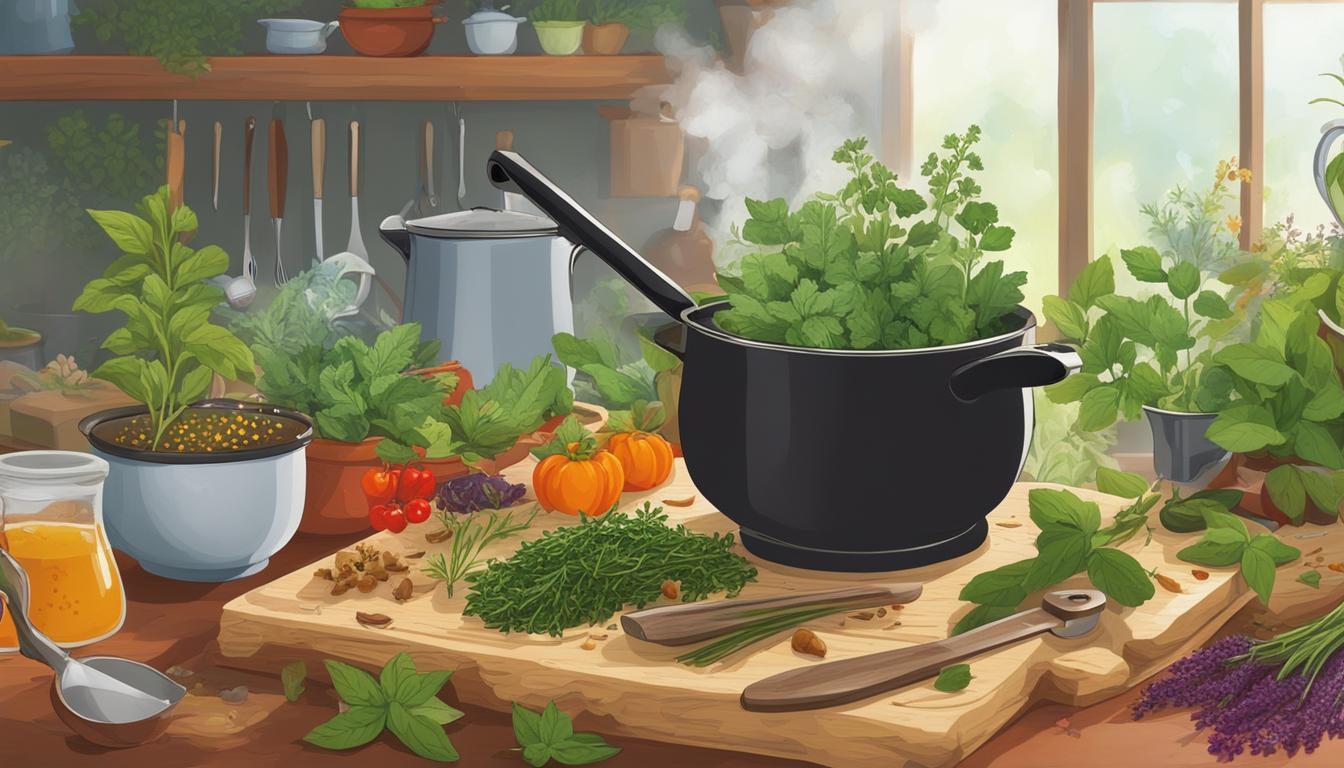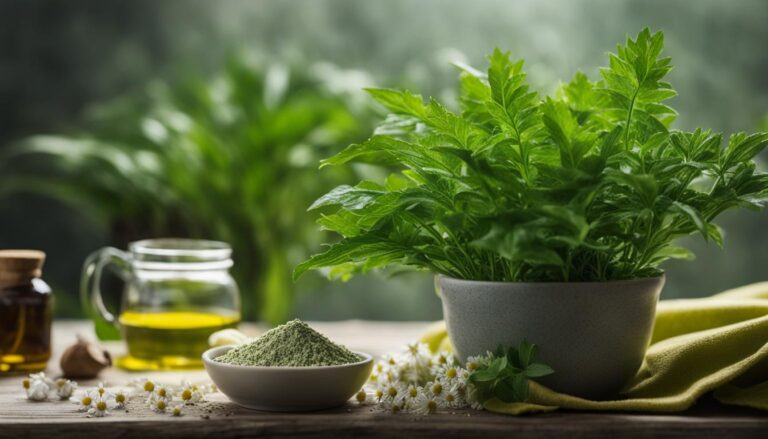
Incorporating medicinal plants into daily cooking can provide both flavor and health benefits. By utilizing ingredients like papaya, turmeric, moringa leaves, ginger, and licorice root, you can easily integrate healing herbs into your meals.
These plants have proven benefits, such as aiding digestion, reducing inflammation, providing essential vitamins, relieving nausea, and preventing sore throat.
With a variety of culinary uses, these medicinal plants can be used in smoothies, fruit salads, teas, pesto, soups, and many other dishes.
Key Takeaways:
- Medicinal plants can be incorporated into daily cooking for flavor and health benefits.
- Papaya aids digestion and can be used in smoothies and fruit salads.
- Turmeric has anti-inflammatory properties and can be used in teas, broths, and golden milk.
- Moringa leaves are packed with vitamins and can be added to pesto, soups, and salads.
- Ginger alleviates nausea and can be consumed as tea or added to soups.
The Benefits of Papaya in Daily Cooking
Papaya, with its sweet and tropical flavor, is not only a delicious fruit but also offers numerous health benefits. One of the key components that give papaya its unique properties is papain, a proteolytic enzyme that aids in protein breakdown and digestion.
This makes papaya a great digestive aid and can help alleviate symptoms of conditions like irritable bowel syndrome and constipation.
Aside from its digestive benefits, papaya is also rich in fiber and short-chain fatty acids, which further support gut health. It contains essential vitamins like vitamin C and vitamin A, providing an immunity boost and promoting overall well-being.
Plus, papaya is low in calories and packed with antioxidants, making it a great addition to a balanced and nutritious diet.
When it comes to culinary uses, papaya can be enjoyed in various ways. You can simply enjoy it fresh on its own, blend it into smoothies for a refreshing treat, or add it to fruit salads and salsas for a tropical twist.
The versatility of papaya makes it a fantastic ingredient in both sweet and savory dishes, allowing you to explore new flavors while reaping its health benefits.
| Nutritional Benefits of Papaya | Per 100g Serving |
|---|---|
| Calories | 43 |
| Carbohydrates | 11g |
| Fiber | 2.3g |
| Vitamin C | 62mg |
| Vitamin A | 950IU |
| Potassium | 182mg |
| Protein | 0.5g |
Adding papaya to your daily cooking not only enhances the flavor of your dishes but also provides a range of health benefits. Whether you’re looking to improve digestion, boost your immune system, or simply enjoy a delicious and nutritious fruit, papaya is a versatile ingredient that can be easily incorporated into your meals.
Harnessing the Power of Turmeric in Your Cuisine
Turmeric, also known as “Indian saffron,” is a versatile spice that not only adds a vibrant yellow color to dishes but also offers numerous health benefits. Its active compound, curcumin, has been studied extensively for its antioxidant and anti-inflammatory properties.
Research has shown that curcumin can help manage exercise-induced muscle soreness, arthritis, and hyperlipidemia. It has even been recommended by the National Psoriasis Foundation for managing psoriasis symptoms.
Incorporating turmeric into your daily cooking is easy and can deliver a burst of flavor and wellness to your cuisine. You can make a spicy herbal tea by steeping turmeric in hot water, or add it to broths and soups for a fragrant twist. Another popular option is to create golden milk by blending turmeric with milk or yogurt. The possibilities are endless!
So why not experiment with turmeric in your recipes and experience the health benefits and culinary delights it has to offer?

Health Benefits of Turmeric
| Benefit | Description |
|---|---|
| Anti-Inflammatory Properties | Curcumin in turmeric has been shown to reduce inflammation in the body, potentially benefiting conditions such as arthritis and psoriasis. |
| Antioxidant Effects | Turmeric’s curcumin is a powerful antioxidant that helps protect against oxidative damage caused by free radicals. |
| Exercise-Induced Muscle Soreness | Studies suggest that turmeric can help alleviate muscle soreness after intense exercise, helping with recovery and reducing discomfort. |
| Arthritis Management | Curcumin has been shown to have anti-inflammatory effects that may help reduce joint pain and stiffness in arthritis patients. |
| Psoriasis Symptom Relief | Research supports the use of turmeric for managing psoriasis symptoms, including redness, itching, and scaling of the skin. |
By harnessing the power of turmeric in your cooking, you can not only add a burst of flavor but also enjoy the many health benefits it provides. So why not give it a try and spice up your meals with this golden treasure?
Moringa Leaves: A Superfood for Culinary Delights
Moringa leaves, also known as the “superfood,” offer a multitude of health benefits and culinary possibilities. Rich in essential vitamins and minerals such as vitamin A, vitamin C, zinc, iron, calcium, magnesium, and potassium, these leaves can provide a nutritional boost to your meals.
One of the key components of moringa leaves is flavonoids, which are potent antioxidants that help protect the body against oxidative stress and reduce the risk of chronic diseases.
These flavonoids also contribute to the anti-inflammatory properties of moringa leaves, making them an excellent addition to a balanced diet.
When it comes to culinary uses, moringa leaves can be a versatile ingredient in a variety of dishes. Finely blending the leaves with pesto creates a vibrant green sauce that can be used as a spread or a dip.
Adding them to chicken noodle soup brings a nutritious twist to a comforting classic. They can also be mixed into rice porridge, curries, and salads for added flavor and nutritional value.
| Benefits of Moringa Leaves | Culinary Uses |
|---|---|
| – Rich in vitamins and minerals – Contains flavonoids with antioxidant properties – Anti-inflammatory effects | – Blended with pesto – Added to chicken noodle soup – Mixed into rice porridge, curries, and salads |
It’s important to note that younger and lighter moringa leaves are preferred as they tend to be less bitter. By incorporating moringa leaves into your culinary creations, you not only elevate the taste and visual appeal of your dishes but also provide your body with a generous dose of health-boosting nutrients.
Did You Know?
Moringa leaves are considered a staple food in many cultures around the world, including India, Africa, and Asia. They have been valued for centuries for their nutritional properties and are often referred to as the “tree of life.”.
Enhancing Flavor and Wellness with Ginger
Ginger, known for its flavorful and medicinal properties, offers a range of benefits for both your taste buds and overall well-being.
With its active compound gingerol, ginger possesses anti-inflammatory and pain-relieving effects. This makes it a popular choice in traditional medicine for alleviating symptoms of nausea, indigestion, and the common cold.
Incorporating ginger into your daily cooking is simple and versatile. You can enjoy a warm cup of ginger tea, which not only provides a soothing and aromatic experience but also aids in digestion.
Ginger can also be used to create a flavorful peanut dipping sauce, adding a delightful spice to your dishes. Additionally, ginger can be added to soups, lending its unique warmth and enhancing the flavors of your favorite recipes.
When using ginger, you have various options in terms of its form. You can choose fresh ginger, which can be grated or chopped for a vibrant and zesty addition to your meals.
Dried ginger, powdered ginger, ginger oil, and ginger juice are also available and can be used depending on your preference and the specific culinary application. Regardless of the form, ginger is a versatile ingredient that adds a distinct and invigorating flavor profile to your dishes.
Exploring the Culinary Uses of Ginger
Ginger can be used in a variety of dishes and cuisines. Here are some popular culinary uses of ginger:
- Stir-fries: Add sliced or grated ginger to your stir-fried vegetables or protein for a burst of flavor.
- Baked goods: Incorporate ground ginger into your cookies, cakes, and bread for a warm and aromatic twist.
- Asian-inspired marinades: Create flavorful marinades for meats and tofu with a combination of ginger, soy sauce, garlic, and other spices.
- Cocktails: Infuse ginger into your favorite cocktails, such as mules or mojitos, for a refreshing and zingy kick.
- Salad dressings: Mix grated ginger with vinegar, oil, honey, and other ingredients to create a tangy and vibrant dressing for your salads.
By exploring the culinary uses of ginger, you can unlock its full potential to both enhance the flavors of your dishes and promote overall wellness.
Exploring the Medicinal Power of Licorice Root in Cooking
Licorice root is a versatile ingredient that offers not only a sweet flavor but also a wide range of health benefits. With its antiviral and antimicrobial properties, licorice root has been used for centuries in traditional medicine. It is particularly known for its ability to prevent postoperative sore throat and improve indigestion symptoms.
One of the culinary uses of licorice root is steeping it in tea. This not only provides a soothing beverage but also allows the medicinal properties of the root to be infused into the hot water.
Additionally, powdered licorice root can be added to spice rubs, enhancing the taste of meat dishes and providing a unique flavor profile.
When incorporating licorice root into your cooking, it’s important to note that moderation is key. Licorice root has a strong flavor, so a little goes a long way. By experimenting with different recipes and techniques, you can discover the perfect balance of taste and health benefits that licorice root offers.
The Benefits of Licorice Root:
- Antiviral and antimicrobial properties
- Prevents postoperative sore throat
- Improves indigestion symptoms
Culinary Uses of Licorice Root:
- Steeped in tea for a soothing beverage
- Added to spice rubs to enhance the flavor of meat dishes

| Benefits of Licorice Root | Culinary Uses of Licorice Root |
|---|---|
| Antiviral and antimicrobial properties | Steeped in tea for a soothing beverage |
| Prevents postoperative sore throat | Added to spice rubs to enhance the flavor of meat dishes |
| Improves indigestion symptoms |
Exploring the World of Culinary Herbs
In addition to incorporating medicinal plants into our daily cooking, culinary herbs play a vital role in enhancing the flavors of our dishes. Basil, bay leaf, cilantro, dill, lemongrass, marjoram, oregano, parsley, rosemary, sage, and thyme are some of the commonly used herbs that add depth and complexity to various cuisines.
Each herb brings its unique taste and aroma to the table, allowing us to experiment with different flavors and create culinary masterpieces. Whether you’re making pasta sauces, soups, salads, or meat preparations, these herbs can provide that extra touch of freshness and fragrance.
Benefits and Culinary Uses of Some Popular Culinary Herbs
Here’s a closer look at some of these culinary herbs and their benefits:
| Herb | Benefits | Culinary Uses |
|---|---|---|
| Basil | Rich in antioxidants, anti-inflammatory properties, and supports heart health. | Used in pesto, salads, and Italian dishes. |
| Rosemary | May enhance memory and concentration, and has antimicrobial properties. | Ideal for roasted meats, potatoes, and bread. |
| Cilantro | Known to aid digestion, regulate blood sugar, and reduce inflammation. | Commonly used in Mexican, Indian, and Thai cuisine. |
| Oregano | Antioxidant-rich, may have antibacterial properties, and supports gut health. | A staple in Italian and Greek recipes like pizza and salads. |
| Thyme | Contains antiseptic compounds and may help relieve respiratory issues. | Great for seasoning soups, stews, and grilled vegetables. |
These herbs can be used in both fresh and dried forms, depending on personal preference and availability. Fresh herbs are typically added towards the end of cooking to preserve their flavors, while dried herbs are often used during the cooking process to infuse their essence into the dish.
By exploring the world of culinary herbs, we can unlock a whole new dimension of taste and aroma, making our meals even more enjoyable and nutritious.
Tips for Cooking with Herbs
As you explore the world of culinary herbs and their benefits, it’s important to know how to incorporate them effectively into your cooking. Here are some valuable tips for cooking with herbs:
- Choosing between fresh and dried herbs: Fresh herbs have a vibrant flavor and aroma, making them ideal for garnishing and adding a burst of freshness to dishes. However, dried herbs have a more concentrated flavor and are perfect for longer cooking times, such as in soups and stews.
- Storage: Properly storing herbs is essential to maintain their freshness. Fresh herbs can be stored in the refrigerator by placing them in a jar of water, similar to flowers. Dried herbs should be kept in airtight containers away from light and heat, which can cause them to lose their potency.
- Understanding flavor profiles: Each herb has its distinct flavor profile. For example, basil offers a sweet and slightly peppery taste, while rosemary has a strong pine-like flavor. Understanding these flavor profiles will help you choose the right herbs for your recipes.
Furthermore, it’s important to know when and how to add herbs to your dishes to maximize their flavors. Whole herbs like bay leaves are typically added at the beginning of cooking to allow their flavors to infuse. On the other hand, chopped herbs are best added towards the end for a burst of freshness.
Experimenting with different combinations of herbs can elevate the taste of your dishes and take them to the next level. Whether you’re making pasta sauces, marinades, or roasted vegetables, herbs are a versatile and essential ingredient in the kitchen.
Remember, cooking with herbs is a creative process, so don’t be afraid to experiment and find your own unique flavor combinations. So go ahead, spice up your meals with the vibrant flavors of herbs and elevate your culinary creations to new heights.

Common Culinary Herbs and Their Flavor Profiles
| Herb | Flavor Profile |
|---|---|
| Basil | Sweet, slightly peppery |
| Cilantro | Fresh, citrusy |
| Oregano | Earthy, slightly bitter |
| Rosemary | Pine-like, aromatic |
| Sage | Earthy, slightly peppery |
| Thyme | Subtly sweet, lemony |
Enriching Your Diet with Medicinal Plants and Culinary Herbs
Incorporating medicinal plants and culinary herbs into my daily cooking has been a game-changer in terms of flavor and overall well-being.
By integrating healing herbs like papaya, turmeric, moringa leaves, ginger, and licorice root into my meals, I have not only enhanced the taste but also reaped the numerous health benefits they offer.
These medicinal plants provide a holistic approach to wellness, aiding in digestion, reducing inflammation, and providing essential vitamins.
From adding papaya to fruit salads to creating golden milk with turmeric and incorporating moringa leaves into soups and curries, there are endless possibilities to explore in the kitchen.
Additionally, culinary herbs like basil, cilantro, rosemary, and thyme have elevated the flavors of my dishes, adding depth and complexity. They can be used in various cuisines and preparations, such as pasta sauces, soups, and meat dishes. Whether using fresh or dried herbs, the aroma they release enhances the overall culinary experience.
By incorporating these medicinal plants and culinary herbs into my meals, I have found a way to enrich my diet while enjoying delicious and nourishing food.
It is essential to consult with a healthcare professional before making any significant dietary changes, especially if you have a chronic condition. Embracing the power of nature in the kitchen can truly make a difference in our overall well-being.
FAQ
How do I use medicinal plants in daily cooking?
Incorporating medicinal plants into daily cooking can be done by utilizing ingredients like papaya, turmeric, moringa leaves, ginger, and licorice root. These plants can be used in smoothies, fruit salads, teas, pesto, soups, and many other dishes.
What are the benefits of papaya in daily cooking?
Papaya offers numerous health benefits, including aiding digestion, relieving constipation, and helping with conditions like irritable bowel syndrome. It is rich in fiber and short-chain fatty acids, making it a potential digestive aid. Papaya can be enjoyed fresh, blended into smoothies, or added to fruit salads and salsas.
How can I harness the power of turmeric in my cuisine?
Turmeric, also known as “Indian saffron,” has antioxidant and anti-inflammatory effects. It can help manage exercise-induced muscle soreness, arthritis, and hyperlipidemia. Turmeric can be added to broths or soups, made into herbal tea, or blended with milk or yogurt to create golden milk.
What are the benefits of moringa leaves in culinary delights?
Moringa leaves are packed with vitamins and minerals and are especially beneficial for people with chronic conditions. They can be added to pesto, chicken noodle soup, rice porridge, curries, and salads.
How can ginger enhance flavor and wellness in cooking?
Ginger has anti-inflammatory and pain-relieving effects and has been used to alleviate nausea, indigestion, and the common cold. It can be consumed as ginger tea, used to make peanut dipping sauce, or added to soups for a warm spice.
What is the medicinal power of licorice root in cooking?
Licorice root offers antiviral and antimicrobial properties and can help prevent postoperative sore throat and improve indigestion symptoms. It can be steeped in tea or added to spice rubs for both relief and taste enhancement.
What are some commonly used culinary herbs?
Basil, bay leaf, cilantro, dill, lemongrass, marjoram, oregano, parsley, rosemary, sage, and thyme are some commonly used herbs in cooking. Each herb adds a unique taste and aroma to dishes.
Do you have any tips for cooking with herbs?
When using whole herbs like bay leaves, add them at the beginning of cooking for longer flavor extraction. Chopped herbs release their aroma when their cells are broken, which is best done before serving. Proper storage of herbs, such as refrigerating them in water or wrapping them in a damp paper towel, helps maintain freshness. Dried herbs should be crushed between fingers before use to release their flavors. Fresh herbs are preferred whenever possible, but dried herbs can be a good substitute.
How can I enrich my diet with medicinal plants and culinary herbs?
By incorporating medicinal plants and culinary herbs into your daily cooking, you can enhance the flavors of your meals while reaping the various health benefits they offer. Experiment with different recipes and techniques to enjoy delicious and nourishing meals. Remember to consult with a healthcare professional before making any significant dietary changes if you have a chronic condition.






2 Comments
Comments are closed.